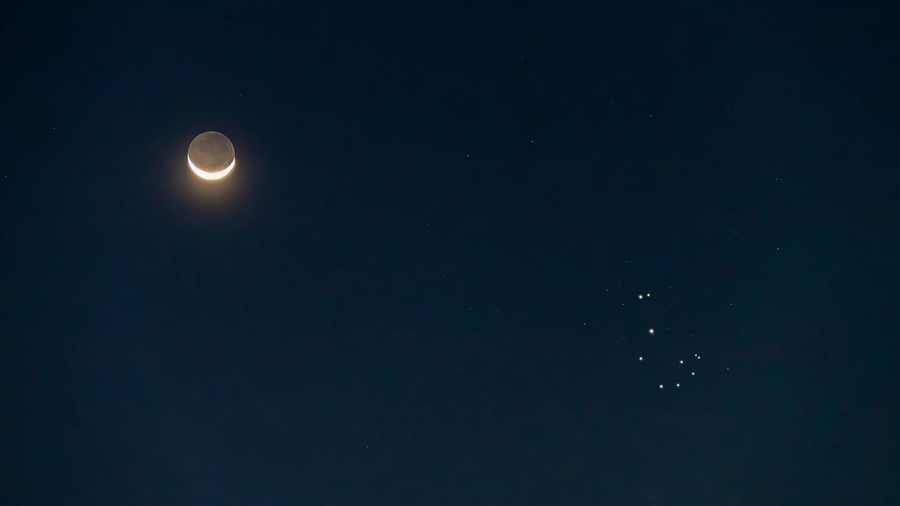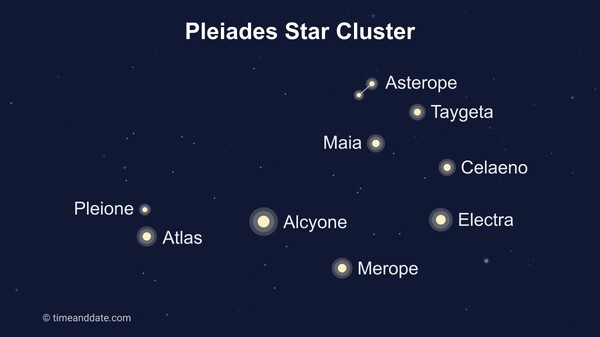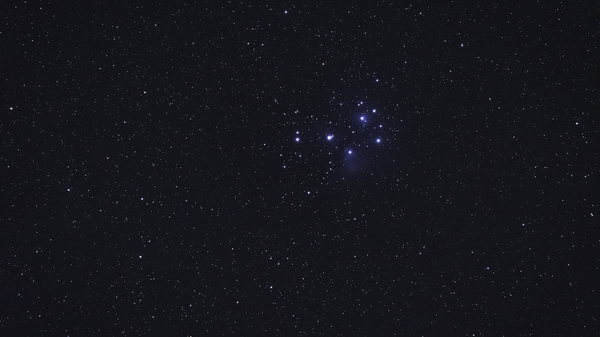
The Moon Occults the Pleiades
In the early morning hours of July 20, the Waning Crescent Moon will pass in front of the Pleiades star cluster, also known as the Seven Sisters, creating a stunning celestial event visible from much of the United States and Canada.
This event is known as a lunar occultation—a phenomenon that occurs when the Moon crosses the line of sight to a distant celestial object, in this case, the Pleiades, temporarily blocking them from view.
How to See the Lunar Occultation
Look close to the horizon in the early morning hours before dawn. For the best chance to see this event, make sure you have an unobstructed view of the eastern horizon.
You can use our Night Sky tool to check the exact times for your location. Search for Alcyone, the brightest star in the cluster, and set the date to July 19–20, then adjust the time slider to find the best viewing moment.
If you’re not in North America to catch this month’s occultation, don’t worry—you may still catch a conjunction instead, where the Moon appears close to the Pleiades in the sky. These close approaches, visible from other parts of the world, still offer a stunning sight for stargazers.
A Rare Occurrence?
Not quite, occultations of the Pleiades have been taking place monthly since September 2023 and will continue through July 2029.
This phenomenon occurs because the Moon’s orbit around the Earth is tilted relative to the ecliptic—the plane of Earth’s orbit around the Sun. During this period, the tilt aligns with the position of the Pleiades in the sky, causing the Moon to pass in front of the cluster around once a month.
So, while the lunar occultations of the Pleiades are not rare at the moment, they are only visible from specific locations on Earth each time.
What Are the Pleiades?
The Pleiades, or Seven Sisters, are among the most recognizable features in the night sky. Known for their distinctive grouping and soft, bluish glow, they are best seen from October through April but can appear near the horizon during the Northern Hemisphere summer months.
- Astronomical name: Messier 45 (M45)
- Distance from Earth: ~445 light years
- Type: Open star cluster
- Number of stars: Over 1000 (only a few visible to the naked eye)
- Brightest stars: Alcyone, Atlas, Electra, Maia, Merope
The Pleiades are part of the Taurus constellation and have an apparent magnitude of 1.6, making them among the brightest open clusters in the sky. As an open star cluster—a group of stars loosely bound by gravity—all of its stars were formed around the same time.

Myths and Cultural Significance of the Pleiades
The Pleiades have inspired myths and stories across the world. Remarkably, many cultures imagined these stars as having been human, typically as sisters, daughters, or maidens.
These stories often reflect the shared human need to explain the unknown. By humanizing something as distant as a star cluster, ancient cultures sought to bring meaning and familiarity to what was mysterious and unreachable.
Greek Mythology: The Seven Sisters
In Greek mythology, the Pleiades were the seven daughters of Titan Atlas and the sea nymph Pleione. Their names—Maia, Electra, Taygeta, Celaeno, Alcyone, Asterope, and Merope—have been immortalized in literature and astronomy alike.
According to one of the legends, the hunter Orion relentlessly pursued the sisters. To protect them, Zeus transformed them into stars, where they remain in the sky, forever chased by Orion’s constellation.
The ancient Greeks also called the Pleiades “the sailing stars.” The poet Hesiod, writing around 700 BCE, advised sailors to avoid voyages when the Pleiades fell below the horizon before dawn, as this signaled the arrival of stormy seas.
The Lost Sister
Despite being called the Seven Sisters, only six stars are typically visible to the naked eye. This gave rise to the mystery of the “lost Pleiad.”
In Greek mythology, the missing star is Merope, who is said to have dimmed her light in shame after marrying a mortal—Sisyphus, the king condemned to endlessly roll a boulder uphill in the Underworld.
Here, myth diverges from current reality. In fact, Merope is one of the brighter stars in the cluster. But, as the only sister to marry a mortal, she became a convenient choice to play the role of the one who vanished. The fact that the story doesn’t align with the sky doesn’t matter—it works symbolically.
The ancient Greeks were not alone in telling this story. Cultures across the world noticed the missing star and developed their own explanations, often featuring a sister who is lost, shy, or hiding.

The Pleiades in Japanese Tradition
In Japan, the Pleiades are known as Subaru, meaning “to unite” or “united.” This name reflects both the cluster’s appearance and its symbolic significance in Japanese culture.
In traditional Japanese farming, the cluster served as a seasonal marker.
A number of local sayings across Japan reflect the Pleiades’ appearance in the sky and their connection to key moments in the rice farming cycle. For example, when they started to appear after sunset in late summer, it was time to prepare for the rice harvest.
The Pleiades in Ancient Calendars
Ancient cultures used the predictable rising and setting of star patterns—such as constellations, asterisms, and notable star clusters—as natural calendars, shaping the development of early zodiacs.
The heliacal rising and setting of these stars (their first appearance before dawn and last appearance after sunset), as well as their position high in the sky, served as seasonal markers in many ancient calendars:
- Northern Hemisphere: The Pleiades’ position high in the sky between the autumn equinox and winter solstice is believed to have aligned with Celtic festivals such as Samhain. For the Celts, this timing coincided with festivals honoring the dead, reinforcing their belief that the cluster served as a window to the Otherworld.
- Southern Hemisphere: In some countries, the Pleiades’ heliacal rising signaled the beginning of the new year and the agricultural season. In New Zealand, the Māori call the cluster Matariki, and its rising marks the start of the new year in their lunar calendar.
The Pleiades Across Time and Space
The Pleiades’ predictable movements allowed early civilizations to track time, plan harvests, and align important festivals with the changing seasons.
Whether guiding sailors, farmers, or storytellers, the Pleiades have helped humanity orient itself in the universe. Their predictable rhythm, celestial beauty, and rich mythology make them more than just a cluster of stars—they are a cultural and cosmic compass.

